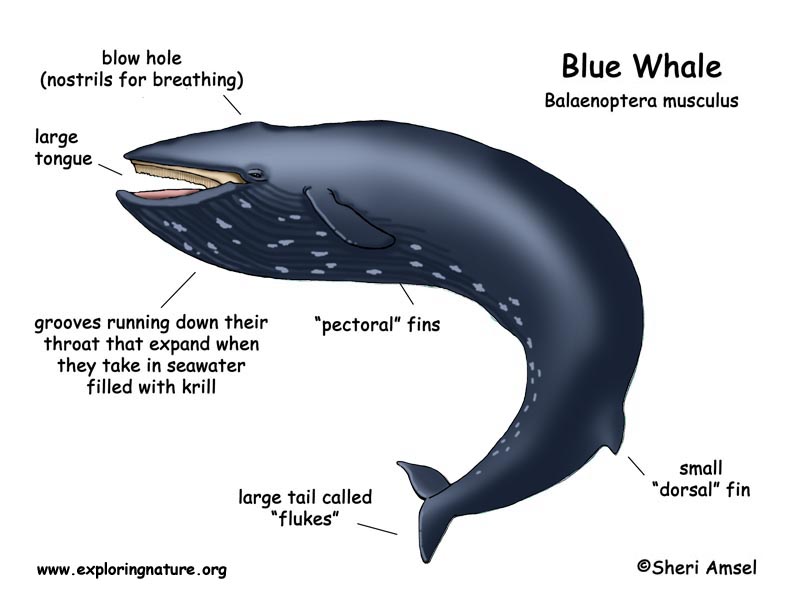

Blue whales are found in all the oceans of the world.
They spend the winters in temperate and subtropical areas, then they migrate to the polar regions in the spring and summer.
The blue whale is the largest animal in the world. They measure between 70-100 feet long and weigh as much as 150 tons (300,000 pounds). Their heart alone can weigh 2,000 pounds. Blue whales do not have teeth. They are baleen whales. This means that they have up to 400 stiff, baleen plates that hang from their upper jaws that act as a filter.
Blue whales swim 14 mph and can go faster. They can dive to deeper than 1,000 feet, but feed in less than 30 feet of water. They can stay underwater from 10 - 20 minutes. They travel alone or in small groups.
The whale gulps in a giant mouthful of water and krill (a tiny shrimp-like animal) and presses their huge tongue against the plates pushing out all the water and keeping the krill. They do this over and over and in this way blue whales eat as much as 4 tons (8,000 pounds) of krill a day.
Their only real predator is man.
Females are pregnant for 12 months (gestation) and have 1 calf. They will not have another for 2-3 years.
The blue whale is thought to be able to live 80 years. They are listed as endangered.
Kingdom: Animalia
Phylum: Chordata
Subphylum: Vertebrata
Class: Mammalia
Order: Cetacea
Suborder: Mysticeti
Family: Balaenopteridae
Genus: Balaenoptera
Species: Balaenoptera musculus
When you research information you must cite the reference. Citing for websites is different from citing from books, magazines and periodicals. The style of citing shown here is from the MLA Style Citations (Modern Language Association).
When citing a WEBSITE the general format is as follows.
Author Last Name, First Name(s). "Title: Subtitle of Part of Web Page, if appropriate." Title: Subtitle: Section of Page if appropriate. Sponsoring/Publishing Agency, If Given. Additional significant descriptive information. Date of Electronic Publication or other Date, such as Last Updated. Day Month Year of access < URL >.
Amsel, Sheri. "Whale (Blue)" Exploring Nature Educational Resource ©2005-2024. December 13, 2024
< http://www.exploringnature.org/db/view/Whale-Blue >

